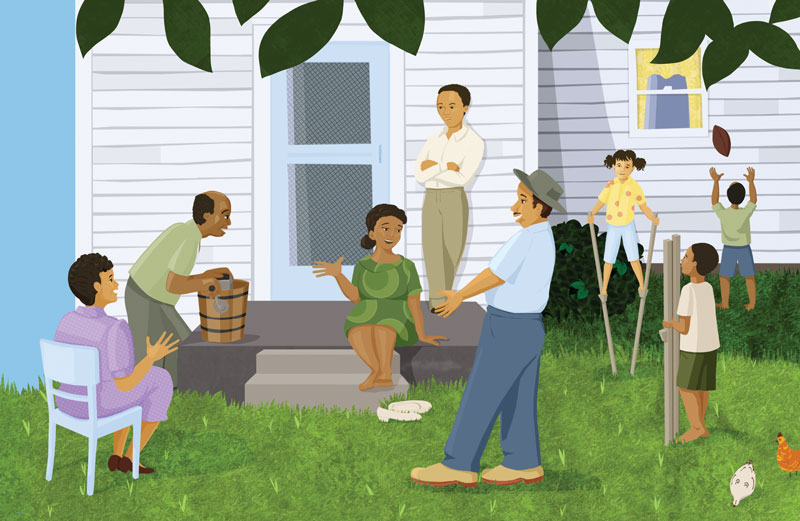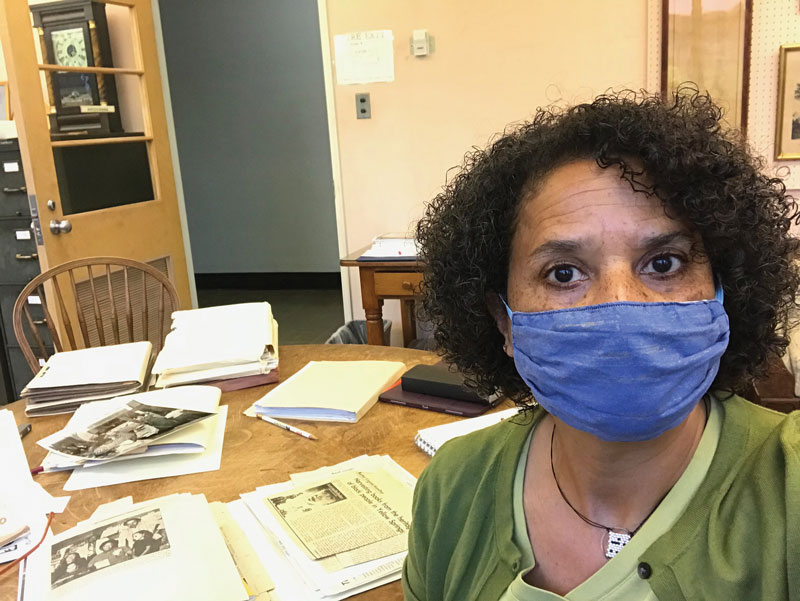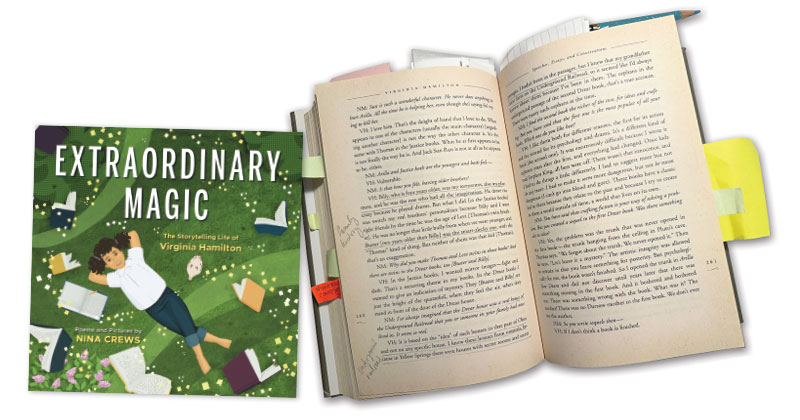Nina Crews on Portraying Virginia Hamilton in 'Extraordinary Magic'
Crews discusses the research that went into her new picture book about the children’s author and literary legend.
 |
Illustration by Nina Crews, based on art from Extraordinary Magic |
Other authors on researching
|
Author and illustrator Nina Crews discusses researching her new biography of children’s book author Virginia Hamilton, Extraordinary Magic: The Storytelling Life of Virginia Hamilton (Little, Brown, Feb 2024), with librarian and blogger Betsy Bird.
Betsy Bird: What drew you to Virginia Hamilton as a subject?
Nina Crews: I was interested in creating a biography of a Black woman creator whose work would be of interest and accessible to young readers. I’d read and loved Hamilton’s books as a child. She was one of the most celebrated children’s authors of her time, and no one had written about her in the picture book space. I read Hamilton’s speeches and essays and found that she often spoke in detail about her childhood and her family and how they connected to her writing. This convinced me her story would resonate with young readers.
 |
Nina Crews at the Antioch College archivesPhotos on this page courtesy of Nina Crews |
Tell us a bit about your research process.
I started by considering what was possible. Could I focus on her childhood, and how much information could I find? I began with Julie Rubini’s middle grade biography, Virginia Hamilton: America’s Storyteller. That led me to Hamilton’s collected speeches, Virginia Hamilton: Speeches, Essays, and Conversations. I found some stories that really stood out, and themes began to emerge.
I am astounded by how much I need to know to write or illustrate nonfiction with any confidence. To write, I needed to understand the context of Hamilton’s experiences. The internet delivered big time. I found a Bryan High School yearbook with photos of Hamilton. I visited Yellow Springs, OH, where she grew up, to get a sense of this place she was so deeply attached to. While there, I went to the collections of Hamilton material at the Antioch College Library and the Greene County Community Library. Both had fat files of clippings about Hamilton and her family. I also reviewed papers she donated to the Library of Congress.
Your interviewed Virginia’s husband, children’s author Arnold Adoff.
It was delightful. When we spoke, I’d been working on the book for almost a year but hadn’t settled on an approach. Adoff confirmed some of my ideas, provided important family history, and told me about their courtship and early years in New York City. And their commitment to diversity in children’s literature—the work she did, and he continued to do.

What surprised you in the course of your research?
I learned a bit about the history of Ohio and abolitionism. Hamilton’s grandfather was just two years old when he was brought to Ohio by his mother to be raised by another family. Coretta Scott King and her older sister, Edythe Scott Bagley, attended Antioch, and Edythe knew Hamilton’s older sister, Nina. I also learned about the big role music played in Virginia’s life. In college, she aspired to be a singer and traveled to New York City to perform in coffeehouses and jazz clubs. She and Arnold met at a jazz club. Charles Mingus was playing.
In her book Willie Bea and the Time the Martians Landed, the children walk on stilts. She told an interviewer that the kids in the family stilted a lot. It’s an African tradition. So I show her on stilts.
What did you think you’d find in your research, but didn’t?
In speeches, Hamilton spoke about the importance of social justice, Black history, and the ways her family was denied fair treatment. Her childhood was in the 1930s and 1940s, well before federal civil rights legislation ended segregation. Ohio public schools had been integrated in the late 19th century. Protests successfully desegregated the Yellow Springs movie theater in 1942. Other businesses like barber shops were desegregated in the 1960s. Hamilton participated in desegregation protests at Woolworths in New York City in the 1960s. I was hoping to get a clearer picture of how she would have understood prejudice as a child. So I focused on how lessons in Black history and pride in her family and community inspired her and provided a place of strength from which to write.
RELATED
The job outlook in 2030: Librarians will be in demand
The job outlook in 2030: Librarians will be in demand
ALREADY A SUBSCRIBER? LOG IN
We are currently offering this content for free. Sign up now to activate your personal profile, where you can save articles for future viewing






Add Comment :-
Be the first reader to comment.
Comment Policy:
Comment should not be empty !!!